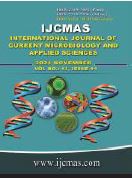


 National Academy of Agricultural Sciences (NAAS)
National Academy of Agricultural Sciences (NAAS)

|
PRINT ISSN : 2319-7692
Online ISSN : 2319-7706 Issues : 12 per year Publisher : Excellent Publishers Email : editorijcmas@gmail.com / submit@ijcmas.com Editor-in-chief: Dr.M.Prakash Index Copernicus ICV 2018: 95.39 NAAS RATING 2020: 5.38 |
Penja white pepper produced in Cameroon is subject to numerous attacks, the most severe of which is parasites, which are one of the causes of the drop in production. The chemical control used is profitable but harmful, not only to health, and not in line with IPG specifications. This study was conducted with the aim of contributing to the improvement of the control of the pepper pathogen through the use of aqueous extract of Erigeron floribundus. To achieve this objective, leaves showing symptoms of anthracnose were harvested for isolation of the pathogen on PDA medium, the pathogenicity test was carried out on the plants, the inhibitory potential of the extracts was assessed using five concentrations (7.5; 15; 30; 60; 120 mg/ml), and the minimum concentrations inhibiting 50 and 90% of the growth of the phytopathogen (MIC50 and MIC90) were evaluated. The results show that two fungi are responsible for anthracnose in pepper: Colletotrichum gloeosporioides and Colletotrichum necator, the pathogenicity test carried out with the two pathogens revealed that Colletotrichum gloeosporioides produced characteristic symptoms with proven severity after 08 days. Inhibition of radial growth of the strain on culture medium was a function of the concentration applied during the study. This inhibition varied from 0% for low concentrations (7.5; 15; 30 mg/ml) to 28.26% for the 60 g/l concentration. For high doses (120 mg/ml) inhibition was 100%. The concentrations inhibiting 50 and 90% of growth were 82.42 g/l and 113.33 mg/ml. This extract showed fungicidal activity at the highest dose and could therefore be used as an alternative method for controlling plant pathogens.
Abdoul A. S., Housson M., Akoulong C. J. 2010. Diagnostic du système national de recherche et de vulgarisation agricoles du Cameroun et stratégie de renforcement des capacités pour la dissémination des connaissances et des technologies agricoles. FAO, 100p.
Anandaraj M. 2000. Diseases of black pepper. In Ravindran P.N. (eds) Black pepper, Piper
nigrum. Medicinal and Aromatic plants-industrial profiles, Hardwood Academic Publischers, The Netherlands, pp. 239-268.
Benattia et Bettayeb., 2015. Evaluation effet allélochimique des extraits aqueux et huile essentielle d’artemisia compertis L. sur quelques souches de fusarium sp p 49
Biyiti LF., Meko'o DL., Tamze, Amvam, Zollo PH., 2004. Recherche de l'Activité Antibactérienne de quatre plantes médicinales Camerounaises. Pharmacie médicale traditionnelle Africaine, 13 : 11-20.
Conway, W.S., Leverentz, B., Janisiewicz, W.J., Blodgett, A.B., Saftner, R.A., Camp, M.J., 2004. Integrating heat treatment, biocontrol and sodium bicarbonate to reduce postharvest decay of apple caused by Colletotrichum acutatum and Penicillium expansum. Postharvest Biology and Technology, 34(1) : 11-20.
Damanhouri Z.A., Ahmad, A. 2014. A Review on Therapeutic Potential of Piper nigrum L. (Black Pepper): The King of Spices. Medicinal and Aromatic Plants, 3(3): 1-6
Djeugap F.J., Fontem D.A. &Tapondjou A.L., 2011.Efficacité in vitro et in vivo des extraits de plantes contre le mildiou (Phytophtora infestans) de la morelle noire. International Journal of Biological Chemical Science, 5 : 2205-2213.
Doga D, Zirihi GN, Zézé A., 2017. Propriétés antifongiques des légumineuses médicinales de Côte d’Ivoire : cas de Crotalaria retusa L. (Fabaceae) sur la croissance in vitro de Phytophthora sp. et Fusarium solani, deux champignons phytopathogènes. European Scientific Journal, 13(3) : 1857-7881.
Dohou N., Yanni K., Badoc A. et Douira A. 2004. Activité antifongique de d’extraits de Tymelaealythroides sur trois champignons pathogènes du riz. Bull.Soc.Pharm Bordeaux, 143 :31-38.
Doumbouya M., Abo K., Lepengue H.N., Camara B., Kanko K., Aidara D., et Kone D. 2012. Activité comparée in vitro de deux fongicides de synthèses et de deux huiles essentielles sur les champignons telluriques des cultures maraichères en Côte d’ivoire. Journal of applied Biosciences, 50: 3520-3532.
FAO. 2012. Perspective de récolte et situation alimentaire. FAO, 40p.
FAOSTAT, 2017. http://www.fao.org/faostat/en/#data. Consulté le 5 novembre 2019.
FAOSTAT, 2022. http://www.fao.org/ faostat/ fr/#data/QC. Consulté le 28 Février 2022.
Gadekar, Y.P., Thomas, R., Anjaneyulu, A.S.R., Shinde, A.T., Pragati, H., 2006. Spices and their role in meat products. A Review Beverage and Food World, 33(7): 57-60.
Galani, Y.J.H., Nguefack, J., Dakole, D.C., Fotio, D., Petchayo, T.S., Fouelefack, F.R., Amvam Zollo, P.H., 2013. Antifungal potential and phytochemical analysis of extracts from seven Cameroonian plants against late blight pathogen Phytophthora infestans. International Journal of Current Microbiology and Applied Science, 2(5): 140-154.
Giordani J. and Sadoux, F. S. 2008. Le poivrier. Le Cameroun agricole pastoral et Forestier
(Douala), 48 : 25-31.
IPC, 2022: http://www.ipcnet.org/ book/? p=d&id=737&start=4&pc=. Consulté le 28 Février 2022.
James B. 2010. Gestion intégrée des nuisibles en production maraichère: Guide pour les agents de vulgarisation en Afrique de l’Ouest. Ibadan, Nigeria : IITA, 9p.
Lepoivre P. 2003. Phytopathologie. Editions De Boeck Paris,427p.
Ling B, Zhang M, Kong C, Pang X, Liang G., 2003. Chimical composition of volatile oil from Chromolaena odorata and its effects on plant, fungi and insect growth. Ying Yong Sheng Tai Xue Bao 14 : 744 pp.
Mazid, M., Khan, T.A., Mohammad, F., 2011. Role of secondary metabolites in defense mechanisms of plants. Biology and Medicine, 3(2): 232-249.
Mboussi S. B, 2016. Lutte contre les bioagresseurs en cacaoculture per l’utilisation des substances pesticides d’origine végétale. Thèse de doctorat université de Yaoundé I, 121p.
Mekam, P.N., Martini, S., Nguefack, J., Tagliazucchi, D., Stefani, E., 2019. Phenolic compounds profile of water and ethanol extracts of Euphorbia hirta L. leaves showing antioxidant and antifungal properties. South African Journal of Botany, 127 : 319-332.
Mohapotra, N.P., Pati, S.P., Ray, R., 2000. In vitro inhibition of Botryodiplodia theobromae (Pat.) causing Java black rot in sweet potato by phenolic compounds. Mohapotra, N.P. & Pati, S.P. & Ray, Ramesh. In vitro inhibition of Botryodiplodia theobromae (Pat.) causing Java black rot in sweet potato by phenolic compounds. Annals of Plant Protection Sciences, 8: 106-109.
Ngono AN., Ebelle RE., Ndifor F., Biyiti L., Amvam Zollo PH, Bouchet P., 2006. Antifungal activity of Chromolaena odorata (L.) King & Robinson (Asteracea) of Cameroon. Chemotherapy, 52: 102-106.
N’Guessan K, Kadja B, Zirihi GN, Traoré D, Aké-Assi L., 2009. Screening phytochimique de quelques plantes médicinales ivoiriennes. Sci. Nat., 6 :1-15.
Nzenowo, E., 2017. Processus de mise en place de l’Indication Géographique Poivre de Penja. Séminaire sur les Indications Géographiques et l’Afrique. Maroc, Casablanca 13-14 Décembre 2017, 16p.
Okigbo R, Ajalie A., 2005. Inhibition of some human pathogens with tropical plants extracts Chromolinaena odorata and citrus aurantifolia and some antibiotics. Inter. J. Mol. Med. Adv.Sci., 1(1): 34-40.
Orsot B.A.M.B., Soro S., Konkon N.G., Kone D., Zirihi G.N., 2015. Étude ethnobotanique et évaluation in vitro de l’activité antifongique des extraits de l’écorce de Zanthoxylum gilletii sur deux souches phytopathogènes de Sclerotium rolfsii. Journal of Applied Biosciences, 98: 9309–9322.
Ouattara E.K., Coulibaly K., Etien T.D. and Zirihi N.G., 2020.Etude ethnobotanique de plantes antifongique utilisées traditionnellement en Cote d’ivoire et dupotential Piliostigma thonningii dans le controle de souches telluriques. International Journal ofBiological and Chemical Sciences, 14(1):239-253.
Pamo, T. E., Tendonkeng F. et Nzogang F.J. (2003). Bioactivité de l’huile essentielle des feuilles de Ocimum gratissimum sur Rhipicephalus lunulatus ectoparasite de la chèvre naine de guinea dansl’ouest-Cameroun. Science Agronomique et développement.
Pandey, D., Tripathi, N., Tripathi, R., Dixit, S., 1982. Fongitoxic and phytotoxic properties of the essential oil of Hyptis suaveolens. Zeitschrift für Pflanzenkrankheiten und Pflanzenschutz, 89: 344-349.
Petchayo, T.S., Nguefack, J.G., Yamdeu, J.H., Fouelefack, F.R., Dakole, D.C., Fotio D., Amvam Zollo, P.H., 2013. Antifungal potential of extracts from four plants against Acremonium apii and Colletotrichum dematium, two major pathogens of celery (Apium graveolens L.) in Cameroon. International Journal of Current Science, 8 : 115-124.
Sarma Y. R., Manohara, D., Premkumar, T., Eapen, S. J. 2010. Diseases and insects’ pests of black pepper (Piper nigrum L.). Lina Building, Jakarta, 116p.
Singh. G., Padvay R. K., Narayanam C. S., Padmhurmeri K. P. and Rao G. P. 1993. Chimical and fongistatic investigation out the essential oils citrus. Pers.Z. dentshezeeishalft fur pflanzenfrankenenundflazenschusstz, 100 :69-74
Smalfield V. I., Eguavoen O. I., Ogbebor N. O., Bosah B. O., Orumwense K., Ijie K. 2001. Control of White Root Rot Disease in Rubber Plantations in Nigeria. International Journal of Microbiology and Immunology Research, 3(4): 46-51.
Svoboda K.P. & Hampson J.B., 1999. Bioactivity of essential oils of selected temperate aromatic plants: antibacterial, antioxidant, antiinflammatory and other related pharmacological activities. Plant Biology Department, SAC Auchincruive, Ayr, Scotland, UK.
Wang, S., Hu, T., Zhang, F., Forrer, H.R., Cao, K., 2007. Screening for plant extracts to control potato late blight. Frontiers of Agriculture in China, 1: 43-46.
Warhan M., Burzynska-Pedziwiatr I. & Woznia L.A., 2008.Review of Natural and Synthetic Important for Heath and Longevity.Current Medicinal Chemistry, 17(28):3262-3288.
Yogesh, M.S., Mokshapathy, S., 2013. Production and export performance of black pepper. International Journal of Humanities and Social Science Invention, 2(4) : 36-44.
Zihiri G. N., Soro S., Kone D. et Kouadio Y. J. 2003. Activité antifongique de l’extrait naturel de Combretumsp. In vitro sur 3 espèces fongiques telluriques des cultures de tomates en Côte d’Ivoire. Rev. Ivoir.Sci. Technol. 11,131-142.
 |
 |
 |
 |
 |